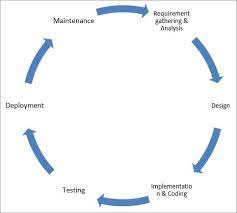Software Development Life Cycle (SDLC) is a process used by software engineers to develop high-quality software in a systematic and organized manner. It is a set of activities that are performed in order to create, maintain, and deploy software applications.
The SDLC process begins with the definition and analysis of the requirements of the software application. This involves understanding the customer’s needs and developing a plan for how the software should function. This phase also includes gathering information about existing systems and technologies that may be relevant to the project.
Once the requirements have been identified, the design phase begins. This is when architects and developers create a blueprint for how the system should work. In this phase, they decide on technology platforms, programming languages, design patterns, and other details of how the system will be built.
The next step is implementation or coding. In this stage, developers write code that implements the design from the previous phase. They also conduct unit testing to make sure that all components are working properly before moving on to integration testing with other components.
After coding is complete, it’s time for system integration testing (SIT). This involves connecting all components together in order to ensure that they are working properly as one system. Once SIT is complete, user acceptance testing (UAT) can begin. UAT is conducted by actual users of the system in order to make sure it meets their needs and expectations before it goes live.
Finally, once UAT has been completed successfully, deployment can occur. During deployment, all necessary files are uploaded to servers or cloud services so that users can access them from anywhere in the world. After deployment has been completed successfully, maintenance begins which involves fixing any bugs or issues that may arise after launch as well as making improvements over time based on user feedback and usage data.
The Software Development Life Cycle (SDLC) provides a structured approach for developing software applications efficiently and effectively while ensuring quality standards are met throughout each stage of development. By following this process from start to finish, engineers can create robust and reliable software applications that meet customer needs while staying within budget constraints
7 Tips for Successful Software Development Life Cycle
- Plan ahead: Make sure to plan out the entire software development life cycle before you begin development.
- Break it down: Break down tasks into smaller, manageable chunks and assign them to members of the team.
- Test early and often: Testing should be done throughout the process to ensure that any errors or bugs are caught as soon as possible, saving time in the long run.
- Track progress: Use a tracking system such as an agile board or project management tool to keep track of progress and monitor deadlines.
- Communicate regularly: Communication is key for successful software development, so make sure everyone is kept up-to-date on changes and progress made by other team members.
- Document changes: Keep a log of all changes made during each phase of the life cycle so that they can be easily referenced later if needed.
- Celebrate successes: Don’t forget to celebrate successes along the way! Achieving milestones is worth celebrating, no matter how small they may seem at first glance!
Plan ahead: Make sure to plan out the entire software development life cycle before you begin development.
Software development life cycle (SDLC) is a process that every software developer should follow to ensure the successful completion of their project. SDLC involves planning, designing, coding, testing and deploying the software. It is important to plan ahead and make sure that all steps are taken into consideration before beginning development.
When planning out the SDLC it is important to consider the scope of the project and timeline for completion. This will help you create a plan that can be followed throughout the entire life cycle and will ensure that all aspects of the project are taken into account. It is also important to consider any potential risks or problems that may arise during development so they can be addressed before they become an issue.
Once a plan has been created, it is important to stick with it throughout the entire process. Allowing for flexibility in certain areas can help keep things moving along but making sure to stay on track with your plan will help keep your project on schedule and within budget.
By taking time to properly plan out your software development life cycle you can ensure that your project runs smoothly and efficiently from beginning to end. Planning ahead will save time and money in the long run and give you peace of mind knowing that you are prepared for any issues or problems that may arise during development.
Break it down: Break down tasks into smaller, manageable chunks and assign them to members of the team.
Software development is a complex process, requiring the collaboration of multiple team members. To ensure that the project is completed efficiently and effectively, it’s important to break down tasks into smaller, manageable chunks and assign them to individual team members.
This approach has several benefits. First, it helps to ensure that each task is completed in a timely manner, as each team member can focus on their specific assignment without having to worry about other tasks on the list. Second, it reduces complexity by breaking down large projects into smaller components that are easier to manage. Third, it allows for better collaboration between team members as they can coordinate their efforts more effectively when they have a clear understanding of what everyone is working on.
Finally, this approach also allows for greater accountability and visibility within the team. When tasks are broken down into smaller chunks and assigned to individual members of the team, it’s easier to track progress and identify any areas where further assistance may be needed. This helps to ensure that all aspects of the project are completed in a timely manner and with high quality results.
In conclusion, breaking down tasks into smaller chunks and assigning them to individual team members is an effective way to ensure efficient and effective software development life cycles. It allows for better collaboration between team members, greater visibility into progress, and increased accountability for each individual’s work.
Test early and often: Testing should be done throughout the process to ensure that any errors or bugs are caught as soon as possible, saving time in the long run.
Software development life cycle is an important process for any software project. One of the key steps in this process is testing. It is essential to test early and often throughout the development process to ensure that any errors or bugs are caught as soon as possible, saving time and effort in the long run.
Testing should start early on, even before coding begins. This allows developers to identify potential issues before they become major problems. As the project progresses, testing should be done frequently at each stage of development. This will help ensure that any bugs or errors are identified and corrected quickly, reducing the risk of a costly fix later on.
It is important for developers to have a clear understanding of how their code works and how it interacts with other components in order to properly test it. Testing should be done systematically in order to identify all potential issues and ensure that they are addressed quickly and effectively.
Testing early and often is essential for successful software projects. By catching errors or bugs early on, developers can save time, money, and effort in the long run. It is important for developers to have an effective testing strategy in place throughout the entire software development life cycle to ensure a successful outcome.
Track progress: Use a tracking system such as an agile board or project management tool to keep track of progress and monitor deadlines.
Having a well defined software development life cycle is essential for any successful software project. One important part of this process is tracking progress. Using a tracking system such as an agile board or project management tool can help keep track of progress and ensure deadlines are met.
Tracking systems allow teams to easily visualize the progress of their projects, providing an overview of tasks that have been completed and those that are still in progress. This helps teams stay on track and avoid delays or missed deadlines. It also allows for better communication between team members, as everyone has a clear understanding of the project’s progress and what needs to be done next.
Using a tracking system also allows teams to identify any potential issues before they become problematic, allowing them to quickly adjust their strategy if necessary. This helps avoid costly delays or unexpected costs due to unforeseen issues.
Overall, tracking progress is an essential part of any successful software development life cycle, and using a tracking system such as an agile board or project management tool can help ensure deadlines are met and potential issues are identified quickly.
Communicate regularly: Communication is key for successful software development, so make sure everyone is kept up-to-date on changes and progress made by other team members.
Software development projects can be complex and require collaboration from multiple teams and individuals. To ensure successful completion of the project, it is important to keep everyone in the loop and communicate regularly.
Effective communication is essential for a successful software development life cycle (SDLC). All team members should be aware of changes and progress made by other team members. This helps to avoid any confusion or miscommunication that could lead to delays or errors. Regular communication also helps to ensure that everyone is on the same page in terms of goals, deadlines, and expectations.
Regular communication can take many forms, such as emails, meetings, or online chats. It is important to establish a clear line of communication between team members so that they can quickly ask questions or provide updates when needed. It is also a good idea to have regular check-ins with the entire team so that everyone knows what progress has been made and what tasks are still outstanding.
Communication is key for successful software development. By ensuring that all team members are kept up-to-date on changes and progress made by other team members, projects can be completed efficiently and without any unnecessary delays or errors.
Document changes: Keep a log of all changes made during each phase of the life cycle so that they can be easily referenced later if needed.
Software development life cycles are essential for successful software development projects. One important step in the life cycle is to document changes. Keeping a log of all changes made during each phase of the life cycle is a critical part of this process.
Documenting changes helps ensure that the software development project is running smoothly and that all changes are tracked and recorded. It also allows developers to easily reference any changes made in the past, which can be helpful if future modifications or bug fixes need to be made. This also helps ensure that no important information or updates are missed or overlooked.
In addition, documenting changes also helps provide an audit trail in case any issues arise during the development process. This way, developers can quickly identify where problems may exist and take appropriate action to address them.
Overall, documenting changes throughout the software development life cycle is an important part of developing successful software applications. It helps ensure that all changes are tracked and recorded, provides an audit trail for future reference, and allows developers to quickly identify any issues that may arise during the development process.
Celebrate successes: Don’t forget to celebrate successes along the way! Achieving milestones is worth celebrating, no matter how small they may seem at first glance!
Software development is a complex and time-consuming process, and it is important to recognize and celebrate successes along the way. Celebrating milestones, no matter how small, can help team morale and provide motivation for future success.
When a milestone is achieved, it’s important to recognize the effort put in by everyone involved. A simple thank you or acknowledgement of the achievements can go a long way in making people feel appreciated. Additionally, celebrating successes can also be a great way to bring team members together and build camaraderie.
On larger projects, it may be beneficial to set up specific rewards or incentives for hitting certain milestones. This could include something as simple as pizza parties or team outings. It’s important to recognize that software development is an iterative process that requires hard work and dedication from everyone involved. Celebrating successes along the way can help reinforce this idea and keep team morale high.
In conclusion, celebrating successes during software development life cycle is essential for keeping teams motivated and engaged throughout the entire process. It’s important to recognize the efforts of everyone involved in order to create an atmosphere of appreciation and collaboration.




